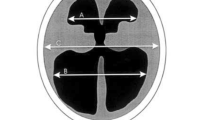Abstract
Introduction
After shunt insertion there is commonly a disproportionate reduction in size of the lateral ventricle containing the catheter (shunted lateral ventricle), which is almost certainly related to shunt function. To explore the difference between two shunt types, the Differential Pressure Medium Pressure cylindrical (M.P.) and Delta 1.5 valves (manufactured by P.S. Medical, Goleta, CA, USA), we measured lateral ventricle volumes preoperatively and after 3 months, using segmentation techniques on CT or MR scans.
Materials and methods
There were 40 patients (mean age 65.7 months), 17 with M.P. and 23 with Delta valves. There were 22 new shunts (8 M.P. and 14 Delta), and 18 revisions (9 M.P. and 9 Delta). Shunted to non-shunted ventricle volume ratios and the difference in ratios (preoperative to 3 months) was calculated. A ratio considerably less than 1 would indicate disproportionate reduction in the volume of the shunted ventricle in comparison to the non-shunted one.
Results
In the new shunt group, the preoperative ratio was 1.63 for M.P. and 1.07 for Delta (p=0.148, one-way ANOVA). The 3-month ratio was 0.71 for M.P. and 1.44 for Delta. The difference in ratios was 0.91 for M.P. and −0.36 for Delta (p=0.042, one-way ANOVA). There were 4 shunt obstructions in this group (3 with M.P. and 1 with the Delta valve). In the revision group, the preoperative ratio was 0.85 for M.P. and 0.88 for Delta (p=0.859, one-way ANOVA). The 3-month ratio was 0.74 for M.P. and 0.60 for Delta. The difference in ratios was 0.11 for M.P. and 0.27 for Delta (p=0.274, one-way ANOVA). There were 5 shunt obstructions in this group (2 with M.P. and 3 with the Delta valve). No correlation was found between incidence of shunt obstruction and shunt type or ventricular volume ratio difference (preoperative to 3 months) in either of the two operation groups.
Conclusions
Following new shunt insertion, the presence of a differential pressure valve results in early significant reduction in the shunted lateral ventricle volume. This may predispose to shunt obstruction although this study has not proven this. This effect was not observed with the Delta valve after 3 months. Following shunt revision, no difference between the two valve types was observed. This may indicate a chronic effect of the presence of a shunt on the ventricular system size, obviating the effect of different shunt types.

Similar content being viewed by others
References
Aschoff A, Kramer P, Benesch C, Fruh K, Klank A, Kunze S (1995) Overdrainage and shunt technology. A critical comparison of programmable, hydrostatic and variable-resistance valves and flow-reducing devices. Childs Nerv Syst 11:193–202
Di Rocco C, Marchese E, Velardi F (1994) A survey of the first complication of newly implanted CSF shunt devices for the treatment of nontumoral hydrocephalus. Childs Nerv Syst 10:321–327
Drake JM, daSilva M, Rutka JT (1993) Functional obstruction of an antisiphon device by raised tissue capsule pressure. Neurosurgery 32:137–139
Drake JM, Tenti G, Sivalsganathan S (1994) Computer modelling of siphoning for CSF shunt design evaluation. Pediatr Neurosurg 21:6–15
Drake JM, Kestle JRW, Milner R, Cinalli G, Boop F, Piatt J Jr, Haines S, Schiff SJ, Cochrane DD, Steinbok P, MacNeil N, Collaborators (1998) Randomised trial of cerebrospinal fluid shunt valve design in paediatric hydrocephalus. Neurosurgery 43:294–305
Jain H, Sgouros S, Walsh AR, Hockley AD (2000) The treatment of infantile hydrocephalus: “differential pressure” or “flow-control” valves? A pilot study. Childs Nerv Syst 16:242–246
Linder M, Diehl JT, Sklar FH (1981) Significance of postshunt ventricular asymmetries. J Neurosurg 55:183–186
Miyake H, Ohta T, Kajimoto Y, Ogawa D (1999) A clinical survey of hydrocephalus and current treatment for hydrocephalus in Japan: analysis by nationwide questionnaire. Childs Nerv Syst 15:363–368
Pudenz RH, Foltz EL (1991) Hydrocephalus: overdrainage by ventricular shunts. A review and recommendations. Surg Neurol 35:200–212
Rekate HL, Brodkey JA, Chizeck HJ, el Sakka W, Ko WH (1988) Ventricular volume regulation: a mathematical model and computer simulation. Pediatr Neurosci 14:77–84
Sahay KB, Kothiyal KP, Banerjee AK (1988) A finite deformation model of infantile hydrocephalus. Int J Neurosci 40:19–29
Sainte-Rose C (1993) Shunt obstruction: a preventable complication? Pediatr Neurosurg 19:156–164
Sainte-Rose C, Piatt JH, Renier D, Pierre-Kahn A, Hirsch JF, Hoffman HJ, Humphreys RP, Hendrick EB (1991–1992) Mechanical complications of shunts. Pediatr Neurosurg 17:2–9
Sgouros S, Malluci C, Walsh AR, Hockley AD (1995) Long term complications of hydrocephalus. Pediatr Neurosurg 23:127–132
Shapiro K, Marmarou A, Shulman K (1993) Abnormal brain biomechanics in the hydrocephalic child. Pediatr Neurosurg 19:216–223
Tuli S, O’Hayon B, Drake J, Clarke M, Kestle J (1999) Change in ventricular size and effect of ventricular catheter placement in pediatric patients with shunted hydrocephalus. Neurosurgery 45:1329–1333
Xenos C, Natarajan K, Sgouros S (2002) Ventricular volume change in childhood. J Neurosurg 97:584–590
Xenos C, Sgouros S, Natarajan K, Walsh AR, Hockley AD (2003) The influence of shunt type in ventricular volume change in hydrocephalic children. J Neurosurg 98:277–283
Acknowledgements
This work is supported by the “Bernard Williams Syringomyelia Research Fund”. We would like to thank Neurosurgeons Mr. A.D. Hockley and Mr. A.R. Walsh for allowing access to the material of their patients. We would like to thank Carol Cummins, Epidemiologist at the Institute of Child Health, for statistical help.
Author information
Authors and Affiliations
Corresponding author
Additional information
The authors have no financial interests in any of the valves assessed in the paper
Rights and permissions
About this article
Cite this article
Jain, H., Natarajan, K. & Sgouros, S. Influence of the shunt type in the difference in reduction of volume between the two lateral ventricles in shunted hydrocephalic children. Childs Nerv Syst 21, 552–558 (2005). https://doi.org/10.1007/s00381-004-1096-y
Received:
Published:
Issue Date:
DOI: https://doi.org/10.1007/s00381-004-1096-y




